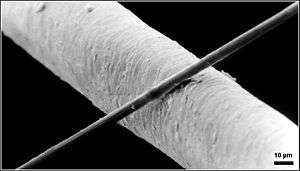Micrometre
The micrometre (international spelling as used by the International Bureau of Weights and Measures;[1] SI symbol: μm) or micrometer (American spelling), also commonly known as a micron, is an SI derived unit of length equalling 1×10−6 metre (SI standard prefix "micro-" = 10−6); that is, one millionth of a metre (or one thousandth of a millimetre, 0.001 mm, or about 0.000039 inch).[1]
| Micrometre | |
|---|---|
 A 6 μm diameter carbon filament above a 50 μm diameter human hair | |
| General information | |
| Unit system | metric |
| Unit of | length |
| Symbol | μm |
| Conversions | |
| 1 μm in ... | ... is equal to ... |
| SI units | 1×10−6 m |
| Natural units | 1.8897×104 a0 |
| imperial/US units | 3.2808×10−6 ft 3.9370×10−5 in |
The next smallest common SI unit is the nanometre, equivalent to one one-thousandth of a micrometre, or one billionth of a metre (0.000000001 m).
The micrometre is a common unit of measurement for wavelengths of infrared radiation as well as sizes of biological cells and bacteria,[1] and for grading wool by the diameter of the fibres.[2] The width of a single human hair ranges from approximately 20 to 200 μm. The longest human chromosome is approximately 10 μm in length.
Examples
.jpg)
Between 1 μm and 10 μm:
- 1–10 μm – length of a typical bacterium
- 10 μm – Size of fungal hyphae
- 5 μm – length of a typical human spermatozoon's head[3]
- 3–8 μm – width of strand of spider web silk[4]
- about 10 μm – size of a fog, mist, or cloud water droplet
Between 10 μm and 100 μm:
- about 10–12 μm – thickness of plastic wrap (cling wrap)
- 10 to 55 μm – width of wool fibre[5]
- 17 to 181 μm – diameter of human hair[6]
- 70 to 180 μm – thickness of paper
SI standardization
The term micron and the symbol μ were officially accepted for use in isolation to denote the micrometre in 1879, but officially revoked by the International System of Units (SI) in 1967.[7] This became necessary because the older usage was incompatible with the official adoption of the unit prefix micro-, denoted μ, during the creation of the SI in 1960.
In the SI, the systematic name micrometre became the official name of the unit, and μm became the official unit symbol.
Additionally, in American English, the use of "micron" helps differentiate the unit from the micrometer, a measuring device, because the unit's name in mainstream American spelling is a homograph of the device's name. In spoken English, they may be distinguished by pronunciation, as the name of the measuring device is invariably stressed on the second syllable, whereas the systematic pronunciation of the unit name, in accordance with the convention for pronouncing SI units in English, places the stress on the first syllable.
The plural of micron is normally "microns", though "micra" was occasionally used before 1950.[8][9][10]
Symbol
The official symbol for the SI prefix micro- is a Greek lowercase mu (μ).[11] In Unicode, there is also a micro sign with the code point U+00B5 (µ), distinct from the code point U+03BC (μ) of the Greek letter lowercase mu. According to the Unicode Consortium, the Greek letter character is preferred,[12] but implementations must recognize the micro sign as well. Most fonts use the same glyph for the two characters.
Notes and references
- "micrometre". Encyclopædia Britannica Online. Retrieved 18 May 2014.
- "Wool Fibre". "NSW Department of Education and Communities". Archived from the original (Word Document download) on 17 June 2016. Retrieved 18 May 2014.
- Smith, D.J.; Gaffney, E.A.; Blake, J.R.; Kirkman-Brown, J.C. (25 February 2009). "Human sperm accumulation near surfaces: a simulation study" (PDF). Journal of Fluid Mechanics. Cambridge University Press. 621: 295. Bibcode:2009JFM...621..289S. doi:10.1017/S0022112008004953. Archived from the original (PDF) on 6 November 2013. Retrieved 20 May 2012.
- Ramel, Gordon. "Spider Silk". Archived from the original on 4 December 2008. Retrieved 14 December 2008.
A typical strand of garden spider silk has a diameter of about 0.003 mm ... Dragline silk (about .00032 inch (.008 mm) in Nephila)
- "Fibreshape applications". IST - Innovative Sintering Technologies Ltd. Retrieved 4 December 2008.
Histogram of Fiber Thickness [micrometre]
- The diameter of human hair ranges from 17 to 181 μm. Ley, Brian (1999). Elert, Glenn (ed.). "Diameter of a human hair". The Physics Factbook. Retrieved 8 December 2018.
- BIPM - Resolution 7 of the 13th CGPM 1967/68), "Abrogation of earlier decisions (micron, new candle.)"
- Proceedings of the Royal Society of Queensland. Part I. XIX. H. Pole & Co. – via Google Books.
- Bigalow, Edward Fuller; Agassiz Association (1905). The Observer. 7–8 – via Google Books.
- 10 micra/10 microns (Start at 1885; before that, the word "micron", singular or plural, was rare)
- "Prefixes of the International System of Units". International Bureau of Weights and Measures. Retrieved 9 May 2016.
- Beeton, Barbara; Freytag, Asmus; Sargent, Murray III (30 May 2017). "Unicode® Technical Report #25". Unicode Technical Reports. Unicode Consortium. p. 11.
External links
